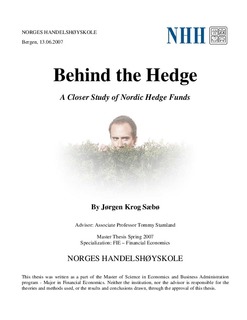| dc.description.abstract | This Master thesis is dedicated to the performance of Nordic hedge funds. A lot of
international studies have been conducted on American hedge funds, but little on Nordic
funds. Common for most of these studies are that hedge funds perform very well
compared to other more traditional assets like stocks and bonds, but that the risk in hedge
funds are somewhat different and usually not captured by traditional financial theory.
Hedge funds often exhibit significant higher order moments while traditional theory only
takes into account the first two moments of the return distribution.
This thesis shows that Nordic hedge funds outperform both American hedge funds and
the general stock and bond markets. They have better distributional properties and riskadjusted
performance measures. The correlation to the stock and bond market is also
relatively low for Nordic hedge funds, even in bear markets and during financial crises.
This offers good diversification benefits, and an optimal portfolio of hedge funds should
consist of around 17-18 individual funds.
Some of this good risk-adjusted performance can however be attributed to general stock
and bond market exposure. This is not consistent with the notion that hedge funds are on
average market neutral. The returns are also influenced by some fund specific factors like
for instance assets under management, age, fees and investment universe. But the good
performance of Nordic hedge funds does not seem to be due to pure luck, but rather
manager skills. This is backed up by the fact that there exists persistence in the hedge
fund returns, especially at shorter horizons (3-6 months). | en |
